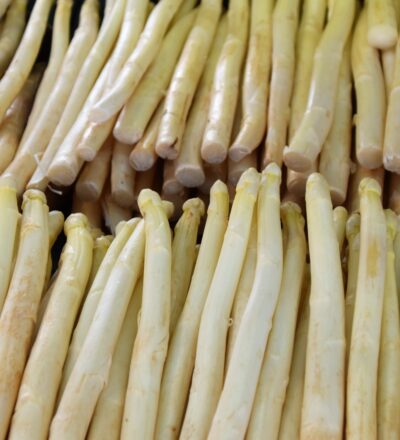Waste2Taste focuses on closing the cycle in food production. The projects aims to reduce agricultural waste by using vegetable waste streams to generate high quality dried powders. So far the project team has published several papers and presented their work at high–impact conferences and symposia. Now that the project is more than half way, it is time to draw up the first results.
Waste2Taste aims to use vegetable waste streams for generating high – quality and flavour – rich dried powders to be used as a clean-label food ingredient in products such as instant soups. As a proof of concept, the project focus lies on white asparagus, given its importance for the Dutch economy, the large amount of waste that is generated during harvest, and the vegetable’s delicate flavour. The latter tends to be modified during the currently-used processing techniques. The acquired knowledge will be applied to other vegetables as well such as bell pepper.
Split-stream process
Two complementary research activities in the Waste2Taste project run simultaneously. The first focuses on the development of the optimal drying strategy for the white asparagus waste streams and the evaluation of the physical properties of the obtained vegetable powders. The second aims to unravel the metabolic pathways related to the asparagus flavour formation. The project team proposes to use a split-stream process in which the asparagus juice is extracted, mildly concentrated and spray-dried with maximum retention of flavour in the powders obtained. The asparagus fibre fraction is processed separately into powder by oven drying and milling. Based on the obtained knowledge on the asparagus chemistry, they evaluate the aroma compounds and study the influence of the drying on aroma composition.
Flavour profile and aroma compounds
In the first half of the project the project team has published a review and two research papers and presented their work at high–impact conferences and symposia. In the review, they summarized most of the published studies on asparagus chemistry highlighting the flavour profile. In addition, their first research publication describes the influence of spray drying conditions and the concentration of the carrier agent maltodextrin on the physical properties and aroma profile of asparagus powder. In the second, they investigated the feasibility of partially replacing maltodextrin with vegetable fibres, and demonstrated that partial replacement is possible while still retaining important aroma compounds.
To further optimize the functionality of asparagus fibre during spray drying, they are currently working on the use of enzymatic hydrolysis to increase the solubility of the asparagus fibre, which is expected to lead to promising results by the end of 2021.
Metabolites pathways
In the context of exploring the metabolome of white asparagus, several varieties from different field locations and harvest time – points have been analyzed, in an untargeted manner using mass spectrometry. Spears were harvested and kindly provided by Teboza BV during the seasons of 2019 and 2020. The generated dataset is a great source of information for understanding the chemistry of white asparagus, and eventually underpinning the selection arguments for the waste streams to be used for the production of powders.
Furthermore, the project team has performed an untargeted analysis for secondary metabolites (including aroma and taste compounds) of both green and white asparagus spears – a comparison that has never been done before. In the same study, they performed spatial metabolomics to demonstrate the location of key aroma compounds along the spears. This information is of great relevance to the proposed use of specific waste materials. Both metabolomic studies are expected to be published by the end of 2021. Both papers will be of great value with regards to the optimal valorization of asparagus waste streams.
To better understand how the chemical composition of asparagus is affected during processing such as cooking, they will analyze and compare the profiles of raw and cooked asparagus varieties this year. Moreover, they will perform metabolomics and sensory analysis of the spray-dried asparagus powders to correlate sensory attributes to specific aroma compounds. These complementary studies will lead to the proposal of the final processing technique and will confirm the predicted metabolic pathways for asparagus flavour formation.
Next steps
In addition to asparagus, Waste2taste is currently also working on bell peppers, which are kindly provided by Growers United BV. The project team uses bell pepper concentrate and perform drying experiments with different spray dryers. An innovative aspect in this study is the use of an electrostatic spray dryer, which is a novel drying technology. The bell pepper powders will be evaluated on their physical properties and aroma composition, and the outcome will contribute in understanding the different spray drying set-ups. Moreover, the spray-dried bell pepper powders will be dissolved in hot water to resemble the instant soup preparation and to confirm the rich aromas that have been retained during the drying.
More information about Waste2Taste or contact Anne van der Zwaan.
Acknowledgement
This project is co-funded by TKI-E&I with the supplementary grant 'TKI- Toeslag' for Topconsortia for Knowledge and Innovation (TKI’s) of the Ministry of Economic Affairs and Climate Policy.
